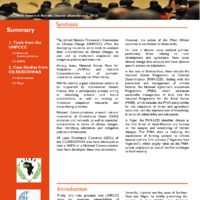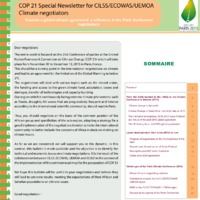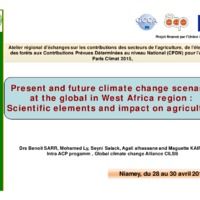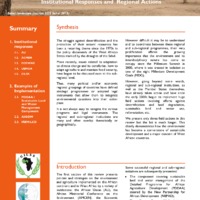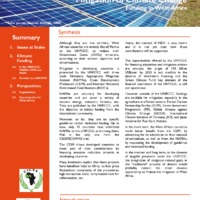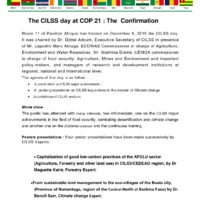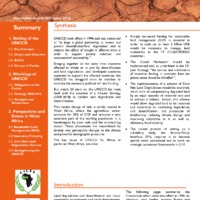Recherche
7 items
Climate change responses from west african states
The United Nations Framework Convention on Climate Change (UNFCCC) offers the developing countries some tools to evaluate their vulnerabilities to climate changes, to plan and to implement adaptation and mitigation policies and measures. Among them, National Action Plans for Adaptation (NAPAs) and National Communications are of particular importance, especially for West Africa. NAPAs identify urgent adaptation actions to be supported by international climate finance, after a participatory process aiming at identifying present and future vulnerabilities, as well as existing or innovative adaptation measures, and hierarchizing priorities. National Communications present national inventories of Greenhouse Gases (GHG) emissions and removals, as well as countries’ vulnerabilities in terms of climate changes, thus identifying adaptation and mitigation policies and measures. All Least Developed Countries (LDCs) of the CILSS/ECOWAS area have developed at least a NAPA or a National Communication; most have developed these two documents. However, the action of the West African countries is not limited to these tools. For over a decade, many national policies, particularly those relating to rural development and agriculture, have taken climate change into account and have planned specific actions on adaptation. In the case of Burkina-Faso, these include the National Action Programme to Combat Desertification (PAN-LCD), dealing with the prevention and management of climate hazards, the National Agriculture Investment Programme (PNIA) which addresses sustainable management of land, and the National Programme for the Rural Sector (PNSR), which includes the PNIA and provides for the adaptation of forest and agricultural resources, and the improvement of knowledge in terms of vulnerability and adaptation. In Niger, the PAN-LCD identifies climate as the first driver of desertification and focuses on the analysis and monitoring of climate changes. The PNIA aims at reducing the dependence of farming systems to climate hazards and the 3-N initiative ("Nigeriens feed Nigeriens"), which largely relies on the PNIA, quotes adaptation as one of the five challenges to food security.
COP 21 Special Newsletter for CILSS/ECOWAS/UEMOA Climate negotiators Towards a global climate agreement: a milestone in the Paris Conference negotiations
Le programme régional « Alliance Mondiale contre le Changement Climatique » (AMCC/GCCA) de l’espace CILSS/CEDEAO est une initiative du groupe Afrique-Caraïbes-Pacifique (ACP) financée par l’Union Européenne. Il vise, entre autres, à renforcer les capacités des pays de la sous-région sur les principaux enjeux liés aux négociations sur le climat. Ce bulletin est principalement destiné aux négociateurs, aux décideurs, à la société civile, aux ONG de l’espace CILSS/CEDEAO, mais aussi à tout lecteur interpellé par la question des changements climatiques. Cet espace dispose, en effet, d’une faible masse critique de négociateurs. Ce bulletin fait le bilan des négociations depuis la Convention de Rio (1992) jusqu’aux Accords de Doha (2012), en passant par la feuille de route de Bali (2007), l’Accord de Copenhague (2009), les Accords de Cancun (2010), le lancement de la Plateforme de Durban (2011). Il présente aussi les enceintes de négociations, les pays et groupes de pays en présence, les principales positions de négociation, les outils du négociateur. Ce bulletin met aussi en relief les points d’achoppement et de blocage des négociations. On insiste notamment sur les engagements des pays développés, la dichotomie entre pays Annexe 1 et pays non Annexe 1, la place des grands pays émergents (Chine Brésil, Inde, etc.), le principe de responsabilité commune mais différencié, etc. Le bulletin démontre également que l’effort global de réduction s’est réduit sur la 2ème période du Protocole de Kyoto 2013-2020 par rapport à 2008-2012. Le niveau d’ambition actuel est trop faible pour espérer rester sous les +2°C et éviter un dérèglement climatique annoncé par le GIEC. Un des points saillants de ce bulletin est le décryptage de l’agenda et des enjeux de la COP19 qui se tiendra du 11 au 22 novembre 2013 à Varsovie. Les principaux points des agendas (COP19, CMP9, SBSTA39, SBI39, ADP2-3) sont classés selon les cinq piliers du plan d’action de Bali à savoir la vision partagée, l’atténuation, l’adaptation, le transfert de technologies et le financement. Le premier point fera a priori l’objet de discussions intenses face aux blocages des négociations sur les engagements d’atténuation. Les positions du groupe Afrique issue de la Déclaration de Gaborone sur le changement climatique lors de la cinquième session extraordinaire de la Conférence ministérielle africaine sur l’environnement sont également présentées. Au regard de la position du groupe Afrique, des orientations spécifiques de négociations ont été identifiées pour l’espace CILSS/CEDEAO par les participants de l’atelier de préparation de la COP19 organisé par le CILSS en octobre 2013 à Ouagadougou. Enfin, le bulletin décrit le rôle et la place du CILSS en tant qu’institution régionale spécialisée sur le climat dans l’appui et l’accompagnement des négociateurs ouest africains
CPDN Session4présentationimpactagricra
Present and future climate change scenario at the global in West Africa region : Scientific elements and impact on agriculture
Desertification and climate change institutional responses and regional actions
The struggle against desertification and the protection of their natural resources has been a recurring theme since the 1970s in the policy documents of the West African States marked by the droughts of the Sahel. More recently, issues related to adaptation to climate change and its corollaries, how to adapt agriculture and maintain food security, have begun to be discussed even at the subregional level. Thus, many political and/or economic regional groupings of countries have defined strategic programmes or adopted legal instruments that allow them to integrate environmental questions into their action plans. It is not always easy to navigate the various programs and legal instruments. The regional and sub-regional institutions are many and often overlap thematically or geographically. Introduction The first section of this review presents policies and strategies on the environment and agriculture implemented on the African continent and in West Africa by a variety of institutions: the African Union (AU), the African Ministerial Conference on the Environment (AMCEN), the Economic Community of West African States (ECOWAS), the West African Economic and Monetary Union (UEMOA), and the Permanent Interstates Committee for Drought Control in the Sahel (CILSS). However difficult it may be to understand and to coordinate between these regional and sub-regional programmes, their very proliferation affirms the growing importance that the environment and its interdisciplinary nature has come to occupy since the Millenium Summit in 2000, where it was treated in isolation as one of the eight Millenium Development Goals (MDG). However, going beyond mere words, regional and sub-regional institutions, as well as the Member States themselves, have already taken action and have since the early 2000s begun to implement huge field actions involving efforts against desertification and land degradation, sustainable land and water use, reforestation, etc. We present only three field actions in this review but the list is much longer. This clearly demonstrates how the environment has become a cornerstone of sustainable development and a major concern of West African countries
Mitigation of climate change funding in west africa
Although they are low emitters, West African countries are invited, like all Parties to the UNFCCC, to reduce their Greenhouse Gases (GHGs) emissions, according to their national capacities and circumstances. Mitigation in developing countries is promoted by the UNFCCC with three tools: Nationally Appropriate Mitigation Actions (NAMAs), Clean Development Mechanism (CDM), and Intended Nationally Determined Contributions (INDCs). NAMAs are voluntary for developing countries and can cover a variety of sectors: energy, transport, forestry, etc. They are published by the UNFCCC, with the objective to attract funding from the international community. However, so far, they are no specific guidelines neither dedicated funding. Up to now, only 15 countries have submitted NAMAs to the UNFCCC, and among them, Mali is the only one from the CILSS/ECOWAS area. The CDM allows developed countries to meet part of their commitments by financing emission reduction projects in developing countries. Many limitations explain that these projects have benefited little to Africa: carbon price fluctuations, complexity of the procedures, high transaction costs, complicated rules for reforestation, etc. Finally, the concept of INDC is very recent and it is not yet clear how these contributions will be supported. The opportunities offered by the UNFCCC for financing adaptation and mitigation actions are tenuous: the target of 100 billion US$/year by 2020 is not credible in the absence of short-term financing and the Green Climate Fund, key element of the financial mechanism of the UNFCCC, is still not operational. However, outside of the UNFCCC, fundings are available for mitigation, especially in the agriculture and forest sectors: Forest Carbon Partnership Facility (FCPF), Forest Investment Programme (FIP), Global Alliance against Climate Change (GCCA), International Climate Initiative of Germany (ICI), and Japan Initiative for Fast-Start Actions. In the short term, the West African countries could better benefit from the CDM, by advocating for its adaptation to their national circumstances, as well as from the NAMAs, by requesting the development of guidelines and dedicated funding. In the medium and long term, in the absence of tangible prospects under the UNFCCC, the integration of mitigation-related goals in the "traditional" projects of donors would probably remain the most obvious opportunity to finance the mitigation in West Africa.
The cilss day at cop 21 : the confirmation
Posters presentations : Four poster presentations have been made successively by CILSS Experts: Capitalization of good low-carbon practices of the AFOLU sector (Agriculture, Forestry and other land use) in CILSS/CEDEAO region, by Dr Maguette Kairé, Forestry Expert; From sustainable land management to the eco-villages of the Boala city, (Province of Namentega, region of the Central-North of Burkina Faso) by Dr. Benoît Sarr, Climate change Expert; CILSS platform in the field of climate change and sustainable land management, by Dr. Issaka Lona, climate change expert; Scaling of smart agriculture for food security in the Sahel, Dr. Edwige Botoni, Natural Resource Management Expert;
United nations convention to combat desertification (UNCCD) : State of play and perspectives for west africa
UNCCD took effect in 1996 and was conceived of "to forge a global partnership to reverse and prevent desertification/land degradation and to mitigate the effects of drought in affected areas in order to support poverty reduction and environmental sustainability." Bringing together at the same time countries affected in whole or in part by desertification and land degradation, and developed countries expected to support the affected countries, the UNCCD has struggled since its creation to mobilise the necessary political will and funding. But, nearly 20 years on, the UNCCD has reset itself with the adoption of a 10-year Strategy (2008-2018) to combat land degradation and desertification. This recent change of tack is sorely needed in West Africa, where the agricultural sector accounts for 35& of GDP and occupies a very extensive part of the working population. It is handicapped by poor soils and the encroaching desert. These phenomena are exacerbated by already very perceptible changes to the climate and powerful demographic pressures. The key issues of UNCCD for Africa, in particular West Africa, are clear: Introduction Land degradation and desertification are major constraints to economic and social development. Inspired by that realisation, African, Latin American, and Mediterranean leaders called into being the UN Convention to Combat Desertification (UNCCD). Translation: Peter Gaechter, SOS Sahel Sharply increased funding for sustainable land management (SLM) is essential in order to scale up: at least 2 billion US$ would be necessary to manage land sustainably in the 17 CILSS/CEDEAO countries ; The Global Mechanism should be implemented and, as underlined in the 10year Strategy, “the sources and mechanisms of innovative funding, in particular from the private sector should be identified ”; The implementation of a scheme of Zero Net Land Degradation should be explored, which aims at compensating degraded land by an equal quantity of restored land and to achieve a balance. Indeed, this scheme would allow degraded land to be restored and contribute to combating degradation and desertification, the protection of biodiversity, reducing climate change, and improving adaptation to it, as well as, obviously, food security; The recent process of setting up a subsidiary body, the Science-Policy Interface (SPI), requires it to become quickly more operational and to work on strategic investment frameworks in SLM.
